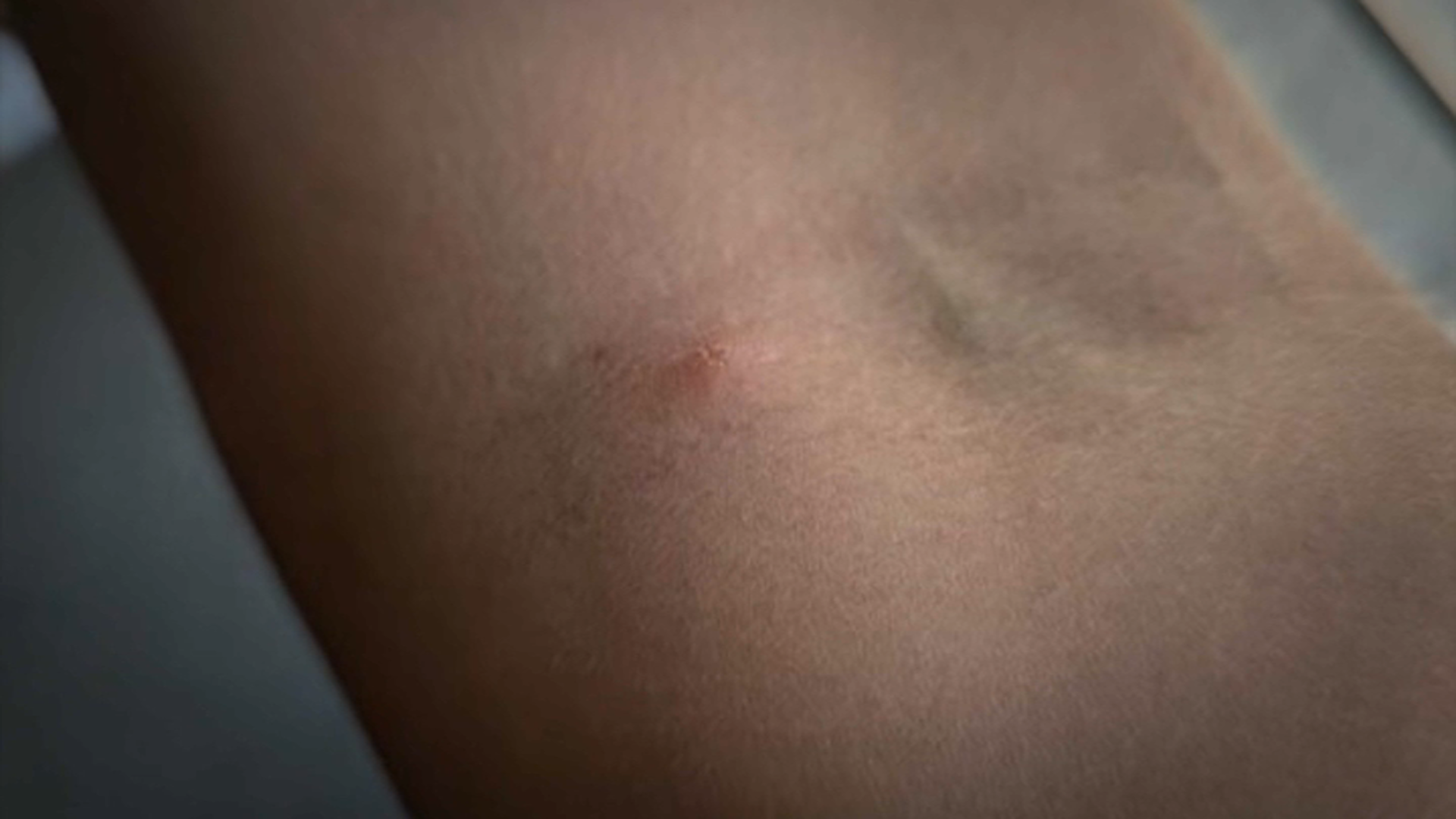Swarms of what appear to be ladybugs are surrounding, and even entering, homes across the Chicago area right now, but they aren't your typical ladybug.
These are known as Asian lady beetles, and for those looking to clean them out of the indoors, there are some things you should know before you have a stinky or potentially unpleasant situation.
Here's what to know:
What are Asian Lady Beetles?
According to the University of Minnesota, the multicolored beetles look similar to other lady beetles, but are typically slightly larger. They are often seen in colors like orange or yellow, but can be seen in red or black, though the latter is rare.
The beetles typically have 19 black spots, though some may have fewer than that or no spots at all, and they have a "clear black 'M'-shaped marking" behind their head, the university notes.
Other names for the beetle include Halloween lady beetle and Japanese lady beetle.

Why are there so many of them right now?
According to Ryan Pankau, a horticulture educator with Illinois Extension, the increase has to do with the time of year.
Feeling out of the loop? We'll catch you up on the Chicago news you need to know. Sign up for the weekly> Chicago Catch-Up newsletter.
"So in their native range, which is in Asia, they would be seeking out rock blocks with cracks in places where they can get back away from the real cold exposure so they can overwinter and then emerge next spring," he told NBC Chicago. "So here in the U.S., our homes and buildings are kind of that habitat for them. So they tend to try and enter through cracks, all those little cracks in your siding or windows, anything on the outside of your house. They're trying to get in right this time of year. And basically they hibernate in the in these cracks throughout the winter and then go back out in the spring."
According to Peggy Anesi, a natural resources, environment and energy educator with the University of Illinois who specializes in wildlife management, people most often notice the bugs in their house in the fall.
"Like many insects, the lady beetle starts seeking small crevices to gather in large numbers and begin diapause, the name for insect hibernation," she wrote in a blog post for the university. "They often inadvertently crawl into basements through cracks in the foundation."
She noted that the large number of such beetles can be alarming for some.
"The Asian lady beetle’s self-invitation causes my phone to ring as early as Halloween. Most people, not so much a naturalist, won’t tolerate even a single bug in the house so imagine the call when someone locates an entire yard full of lady beetles in the corner of their basement," Anesi said.
Similar, the University of Minnesota said "once lady beetles move into wall voids in the fall there is no way to prevent them from emerging later during winter or spring."
What if you have them in your home?
The University of Minnesota notes that the beetles "can be a nuisance when they occur in large numbers inside homes," but overall they are not harmful to humans or pets.
While the beetles are common in wooded areas and gardens, they can be beneficial as they feed on garden pests such as aphids. But if they run out of aphids to eat, they may begin looking for other food sources and land on fall fruits like grapes or apples, infesting those that have wounds or holes.
"Outdoors, Asian lady beetles helpfully feed on plant pests like aphids and many others. From September to November, they move indoors to overwinter, crawling along windows and walls. Small cracks around windows and door frames provide entry points," Orkin reported. "While indoors, the pests search for moisture or humidity and bask in warm portions of the building when possible. Houses near woods or fields are prone to infestation, although any building can attract the pests. Contrasting shades of light and dark, like blacks against a white background also attract Asian lady beetles."
Orkin said the beetles are nuisances simply because of their large numbers and because infestations can be "hard to control."
"The most troubling sign of multicolored Asian lady beetles is the appearance of large numbers of adults on and around buildings. This occurs during the fall with renewed activity on warm winter days and again in the spring," Orkin said. "The larvae may be seen on plants or outdoor surfaces, but due to their radically different appearance from the adults, may not be recognized."
Can you prevent these beetles from infesting your home in the fall?
Experts recommend eliminating spaces where such beetles can enter your home, though it can be challenging as these bugs can fit through openings as small as 1/8-inch.
The timeline for sealing up openings would be before the end of September, according to the University of Minnesota.
Here are some of their recommendations:
- Check the outside of your home for spaces and cracks that may allow insects easy entry.
- Lady beetles can fit through openings as small as 1/8 inch in size.
- Make any necessary repairs by the end of September.
- Seal cracks and spaces around doors, windows and fascia boards. Check for gaps and cracks where different materials meet, such as brick and wood siding. Seal cracks with caulk, such as silicone, elastomeric latex or silicone/acrylic.
- Seal areas where cable TV wires, phone lines, and other utility wires and pipes, outdoor facets, dryer vents and similar objects enter buildings.
- Seal with caulk or, for larger spaces, use polyurethane expandable spray foam, steel wool, copper mesh or another appropriate sealant.
- Repair or replace damaged window and door screens.
- Repair or replace damaged screens in roof and soffit vents, and in bathroom and kitchen fans.
- Install door sweeps or thresholds to all exterior entry doors. Install a rubber seal along the bottom of garage doors.
You could use a pesticide outside to prevent entry into your home as well, some experts say. Others say spraying pesticides is "unnecessary."
Pankau noted that prevention can be tricky, however.
"It takes a lot of meticulous caulking and clogging those cracks to keep them out. And you really can't have any of those spaces open or they're going to get in," he said.

What can you do if they're already in your home?
Once inside your home, spraying pesticides for these beetles is largely ineffective.
Experts are mixed on the preferred method for removing Asian Lady Beetles, however.
Anesia suggests sweeping the beetles out of your home "because if you vacuum up a pile of them in the winter the smell will make you change the vacuum bag before it's full."
The University of Minnesota, however, said vacuuming is a viable option, but it also notes that "lady beetles are not automatically killed when they are vacuumed" so changing the bag frequently is recommended for minimizing smell.
"You may use a knee-high nylon stocking that has been inserted into the extension hose and secured with a rubber band. As you vacuum, the lady beetles are captured in the stocking," the university suggests. "Remove the stocking after vacuuming, so the captured beetles won't escape."
Orkin also suggests trying "insect light traps in locations that stay relatively dark and attractive to ladybug beetles such as attics."
Do Asian Lady Beetles bite?
They don't damage property and they cannot sting, but they can bite if they are searching for moisture or food.
While the bites are typically minor, they can lead to allergic reactions for some.
"Their bites may feel like a pinch and can break the skin, which may cause minor discomfort. Allergic reactions to Asian lady beetles, including itchy eyes and nose, asthma, welts, and swelling can occur for some people," Orkin reported.
What is the yellow liquid they release?
"If you disturb any lady beetle, you will be amazed at the amount of foul smell from a yellow discharge they can admit through their leg joints," Anesi said. "This is their defense mechanism that keeps other animals from wanting to snatch them up."
According to Orkin, the foul-smelling yellow liquid released by some of these beetles is called "reflex bleeding."
"This can happen when they are crushed or feel threatened. The yellow liquid is not dangerous or poisonous, but it can cause minor allergic reactions. Reflex bleeding can stain walls or clothing," Orkin reported.
What's the difference between Asian lady beetles and ladybugs?
Asian lady beetles are not native to Illinois, but there are some ladybugs that are.
"So our native ladybugs are a little bit smaller," Pankau said. "They're a very consistent red color, kind of a bright reddish color, where the Asian lady beetles - a lot of times we call them multicolored Asian lady beetles - are different colors. They have different numbers of spots. Some you'll see won't even have spots. And a big difference is that in, you know, in nature, our lady beetles, our ladybugs are native insects. Rarely do you see them congregating or in groups, especially this time of year. Maybe when they emerge in the spring, you might find some together. But this time of year, they're solitary, they're alone."



